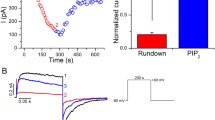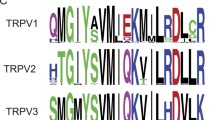Abstract
The causes of attenuation of Na+ currents by diacylglycerol (DAG)-induced protein kinase C (PKC) activation in mouse neuroblastoma N1E-115 cells were investigated using the cell-attached patch, and the perforated-patch (nystatin based) whole-cell voltage-clamp techniques. Activation of PKC by DAG attenuated Na+ currents. Attenuation occurred in the absence of significant changes in the time-course of Na+ currents. However, the steady-state inactivation curve of these currents shifted to more negative voltages by approximately 20 mV. Here we demonstrate that the time-course of inactivation is accelerated by treatment with DAG-like substances in a voltage-dependent manner (time constant of inactivation decreased by 2- and 3.6-fold at −60, and −30 mV, respectively). In cell-attached patches, treatment with DAG compounds increased the percentage of current traces showing no single Na+ channel openings in response to depolarizing voltage-clamp pulses. Moreover, the average of current traces containing single Na+ channel openings was essentially the same in control conditions and after treatment with DAG compounds. Removal of Na+ channel inactivation by the alkaloid batrachotoxin prevented the attenuation of Na+ currents by PKC activation via DAGs. Taken together, these data strongly suggest that PKC-induced attenuation of Na+ currents is linked to an enhancement of Na+ channel inactivation. This attenuation is caused by an increase in the number of Na+ channels inactivating directly from the closed state(s). This inactivation pathway represents a simple and efficient physiological mechanism by which PKC activation might modulate the electrical activity of excitable cells.
Similar content being viewed by others
References
Aldrich RW, Stevens CF (1983) Inactivation of open and closed sodium channels determined separately. Cold Spring Harb Symp Quant Biol 48:147–153
Aldrich RW, Corey DP, Stevens CF (1983) A reinterpretation of mammalian sodium channel gating based on single-channel recording. Nature 306:436–441
Armstrong CM, Bezanilla F (1977) Inactivation of the sodium channel. II. Gating current experiments. J Gen Physiol 70:567–590
Bean BP (1981) Sodium channel inactivation in crayfish giant axon. Must channels open before inactivating? Biophys J 35:595–614
Benz I, Herzig JW, Kohlhardt M (1992) Opposite effects of angiotensin II and the protein kinase C activator OAG on cardiac Na+ channels. J Membr Biol 130:183–190
Bezanilla F, Armstrong CM (1977) Inactivation of the sodium channel. I. Sodium current experiments. J Gen Physiol 70:549–566
Catterall WA (1992) Cellular, molecular biology of voltagegated sodium channels. Physiol Rev 72:S15-S48
Costa MR, Catterall WA (1984) Phosphorylation of the alpha subunit of the sodium channel by protein kinase C. Cell Mol Neurobiol 4:291–297
Cukierman S (1991) Inactivation modifiers of Na currents and the gating of rat brain sodium channels in planar lipid membranes. Pflügers Arch 419:514–521
Cukierman S (1992) Characterization of K+ currents in rat malignant lymphocytes (Nb2 cells). J Membr Biol 126:147–157
Dascal N, Lotan I (1991) Activation of protein kinase C alters voltage dependence of a Na+ channel. Neuron 6:165–175
Emerick MC, Agnew WS (1989) Identification of phosphorylation sites for adenosine 3′, 5′-cyclic phosphate dependent protein kinase on the voltage-sensitive sodium channel from Electrophorus electricus. Biochemistry 28:8367–8380
Godoy CM, Cukierman S (1994) Multiple effects of protein kinase C activators on Na+ channels in mouse neuroblastoma cells. J Membr Biol 140:101–110
Hille B (1992) Ionic channels of excitable membranes. Sinauer, Sunderland Mass.
Hodgkin AL, Huxley AF (1952) A quantitative decription of membrane current and its application to conduction and excitation in nerve. J Physiol (Lond) 117:500–544
Horn R, Marty A (1988) Muscarinic activation of ionic currents measured by a new whole-cell recording method. J Gen Physiol 92:145–159
Huang LYM, Moran N, Ehrenstein G (1984) Gating kinetics of batrachotoxin-modified sodium channels in neuroblastoma cells determined from single-channel measurements. Biophys 145:313–321
Kaczmarek LK, Levitan IB (1987) Neuromodulation. The biochemical control of neuronal excitability. Oxford University Press, New York
Khodorov BI, Revenko SV (1979) Further analysis of the mechanism of action of batrachotoxin on the membrane of the myelinated nerve. Neuroscience 4:1315–1330
Korn SJ, Marty A, Connor JA, Horn R (1991) Perforated patch recording. Methods Neurosci 4:264–373
Li M, West JW, Numann R, Murphy BJ, Scheuer TL, Catterall WA (1993) Convergent regulation of sodium channels by protein kinase C and cAMP-dependent protein kinase. Science 261:1439–1442
Linden DJ, Routtenberg A (1989) Cis-fatty acids, which activate protein kinase C, attenuate Na+ and Ca2+ currents in mouse neuroblastoma cells. J Physiol (Lond) 419:95–119
Lotan I, Dascal N, Naor Z, Boton R (1990) Modulation of vertebrate brain Na+ and K+ channels by subtypes of protein kinase C. FEBS Lett 267:25–28
Moorman JR, Kirsch GE, Brown AM (1989) Angiotensin II and phorbol ester modulate cardiac sodium channels in neonatal rat (abstract). Biophys J 55:229a
Murphy BJ, Catterall WA (1992) Phosphorylation of purified rat brain Na+ channel reconstituted into phospholipid vesicles by protein kinase C. J Biol Chem 267:16129–16134
Numann R, Catteral WA, Scheuer T (1991) Functional modulation of brain sodium channels by protein kinase C phosphorylation. Science 254:115–118
Qu Y, Rogers J, Tanada T, Scheuer T, Catterall WA (1994) Modulation of cardiac Na+ channels expressed in a mammalian cell line and in ventricular myocytes by protein kinase C. Proc Natl Acad Sci USA 91:3289–3293
Rack M, Rubly N, Waschow C (1986) Effects of some chemical reagents on sodium current inactivation in myelinated nerve fibers of the frog. Biophys J 50:557–564
Rossie S, Catterall WA (1987) Cyclic AMP-dependent phosphorylation of voltage-sensitive sodium channels in primary cultures of rat brain neurons. J Biol Chem 262:12735–12744
Sigel E, Baur R (1988) Activation of protein kinase C differentially modulated neuronal Na+, Ca2+, and gamma-aminobutyrate type A channels. Proc Natl Acad Sci USA 85:6192–6196
Tanguy J, Yeh JZ (1991) BTX modification of Na channels in squid axons. I. State dependence of BTX action. J Gen Physiol 97:499–520
Vandenberg C, Horn R (1984) Inactivation viewed through single sodium channels. J Gen Physiol 84:535–564
West JW, Numann R, Murphy BJ, Scheuer T, Catterall WA (1991) A phosphorylation site in the Na+ channel required for modulation by protein kinase C. Science 254:866–868
Yang J, Barchi R (1990) Phosphorylation of the rat skeletal muscle sodium channel by cyclic AMP-dependent protein kinase. J Neurochem 54:954–962
Author information
Authors and Affiliations
Rights and permissions
About this article
Cite this article
Godoy, C.M.G., Cukierman, S. Diacylglycerol-induced activation of protein kinase C attenuates Na+ currents by enhancing inactivation from the closed state. Pflugers Arch. 429, 245–252 (1994). https://doi.org/10.1007/BF00374319
Received:
Revised:
Accepted:
Issue Date:
DOI: https://doi.org/10.1007/BF00374319




